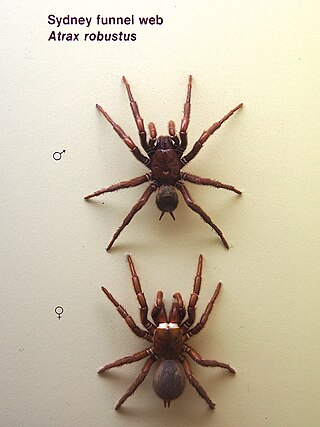Career
In 1968 Gray started as Assistant Curator of Arachnology at the Australian Museum. By 2003, Gray had progressed to the position of Principal Research Scientist. [6] [4]
Gray's research interests included the systematics of Australian funnel-web spiders (Atracidae). [7]
Of particular public interest along with Gray’s funnel-web work, was a collection of papers co-written with medical doctor Geoff Isbister relating to spider bites. [4] [8] [9] [10]
This work debunked the myth of flesh eating necrosis being caused by a bite from an Australian White-tailed spider (Lampona spp.). In 2004, Isbister and Gray were nominated as finalists in the Australian Skeptics Eureka Prize for Critical Thinking, for their paper on the White-tailed spider bite. [11] [12]
Cave spiders were another research interest, with Gray undertaking fieldwork in Jenolan Caves, Wombeyan Caves and caves on the Nullarbor Plain. [13] [14] [15] [16]
Notable surveys Gray was involved in include the World Heritage Rainforests Survey with the Queensland Museum, the Lord Howe Island Survey, and the North East Forests Biodiversity Survey with NSW National Parks and Wildlife Service. [4]
Equally important to his research was public engagement. Throughout his career, Gray was regularly interviewed by media outlets. Through these interviews he tried to educate and build public interest in spiders. In 1997, Gray curated the Spiders! exhibition at the Australian Museum. [17] [4]
Scientific committees and societies Gray has been a member of include:
Gray was particularly active within the Linnean Society having been a member since 1981, then a council member in 1988 and President in 2012-2013. [4]
Gray was an Honorary Associate in the Faculty of Science and the Faculty of Agriculture Food and Natural Resources at the University of Sydney. Gray supervised many students studying for Honours, Masters, and PhD degrees. He also became a mentor to retired pharmacist Graham Wishart, developing Wishart's interest in Trapdoor spiders. [18] [19] [20] [4]
Gray retired in 2009 and in 2010, as a retired fellow of the Australian Museum, published his PhD thesis findings A revision of the Australian funnel-web spiders (Hexathelidae: Atracinae). [21] [4]
Gray's field work has resulted in almost 11,000 specimen lots registered in the Australian Museum database under his name. Gray introduced contemporary curatorial techniques and standards to registering arachnology specimens at the Australian Museum. In 1977, with the support of an assistant, he started databasing specimens. By 1990, 28,000 specimens had been recorded. As of 2023, over 131,000 arachnological specimens are represented in the Australian Museum database. [4]
This page is based on this
Wikipedia article Text is available under the
CC BY-SA 4.0 license; additional terms may apply.
Images, videos and audio are available under their respective licenses.





